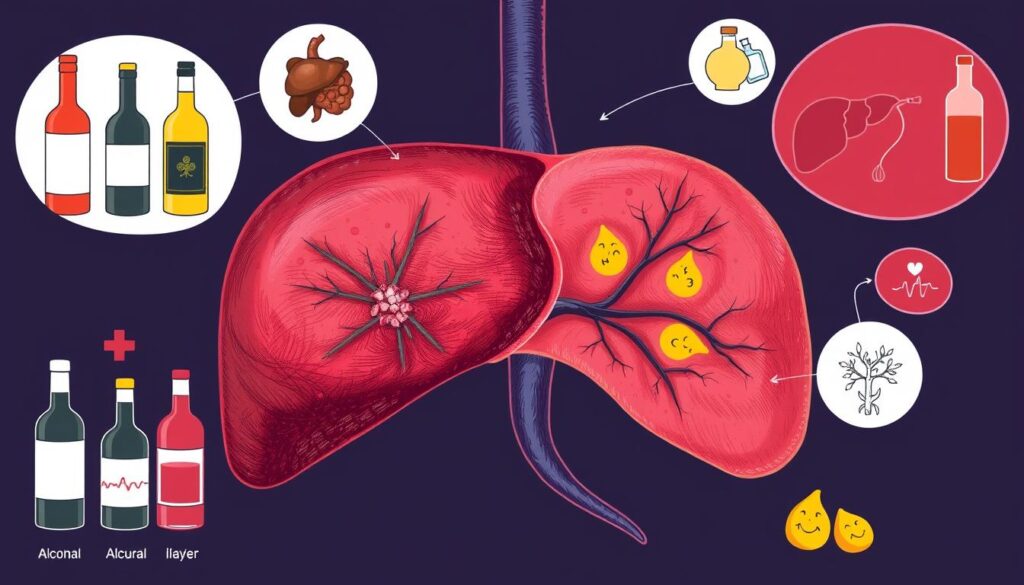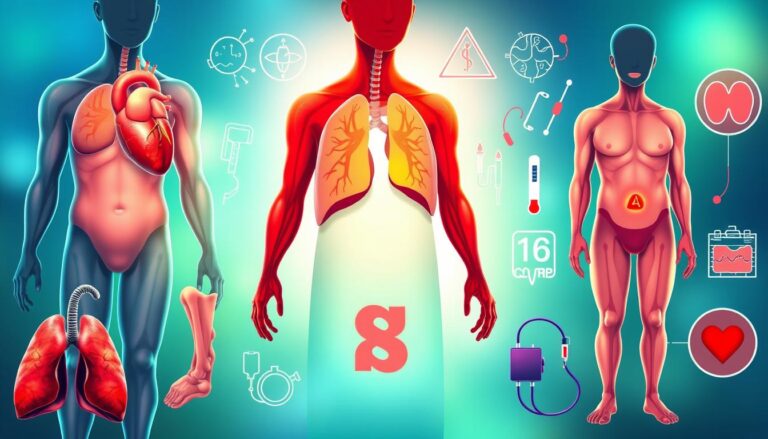The liver is a vital organ that does many important jobs. It helps with digestion, removes waste, and even helps with blood clotting and hormone production. But, it can face health problems. Liver disease can come from viruses, immune issues, or lifestyle choices like drinking too much alcohol and being overweight.
It’s important to catch liver disease early. If not, it can get worse and lead to serious problems like cirrhosis and liver failure.
Do you know the signs that your liver might be in trouble? Spotting these symptoms early can help you get the right care quickly. Signs include feeling very tired, yellowing of the skin and eyes, and pain in the belly. Knowing these signs can help keep your liver healthy.
Key Takeaways
- The liver is a versatile organ that plays a crucial role in our overall health.
- Liver disease can have various causes, including viral infections, immune system disorders, and lifestyle factors.
- Early detection of liver problems is essential, as the condition can progress to more severe issues if left unchecked.
- Recognizing common symptoms of liver distress, such as jaundice, abdominal pain, and unexplained fatigue, is the first step in seeking medical attention.
- Maintaining a healthy liver through lifestyle choices, regular check-ups, and prompt treatment can help prevent long-term complications.
Overview: The Importance of a Healthy Liver
The liver is a vital organ that plays a crucial role in our overall health and well-being. It breaks down nutrients, produces bile, and filters harmful substances. When the liver function is compromised, serious health issues can occur.
What the Liver Does
The liver is a powerhouse, performing over 500 different functions in the body. It includes:
- Metabolizing and storing nutrients from the food we eat
- Producing bile to aid in the digestion and absorption of fats
- Filtering toxins and other harmful substances from the bloodstream
- Regulating blood clotting
- Storing essential vitamins and minerals
- Helping to maintain a healthy immune system
Liver Disease and Its Progression
When the liver is damaged, it can lead to liver disease progression and stages. The disease starts with inflammation, then fibrosis (scarring), and eventually cirrhosis. Cirrhosis can lead to liver failure, a life-threatening condition, without treatment.
| Stage of Liver Disease | Description |
|---|---|
| Inflammation | The liver becomes inflamed, often due to viral infections, alcohol abuse, or autoimmune disorders. |
| Fibrosis | Scar tissue begins to form in the liver, which can impair its ability to function properly. |
| Cirrhosis | Extensive scarring and the replacement of healthy liver tissue with scar tissue, leading to a loss of liver function. |
| Liver Failure | The liver is no longer able to perform its essential functions, which can be life-threatening without a liver transplant. |
Understanding the importance of a healthy liver and the stages of liver disease progression is crucial. Recognizing problems early and seeking medical attention can prevent disease advancement and complications.
How Do You Know if Your Liver is Struggling?
Common Symptoms of Liver Problems
In the early stages, liver problems might not show any symptoms. But as the disease gets worse, you’ll start to notice signs. One clear sign is jaundice, which makes your skin and eyes turn yellow due to too much bilirubin in your blood.
Other signs of signs of liver disease include:
- Abdominal pain or discomfort
- Swelling in the legs or abdomen
- Itchy skin
- Dark urine
- Pale, clay-colored stools
- Constant fatigue
- Nausea and loss of appetite
These symptoms mean your liver might not be working right. You should see a doctor to check and figure out what’s wrong.
| Symptom | Explanation |
|---|---|
| Palmar erythema | Roughly a quarter of people with liver cirrhosis develop this reddening of the skin on the palms. |
| Spider naevi | Small spider-shaped arteries that appear in clusters on the skin, and may suggest liver disease when found in larger numbers on the upper half of the body or in men. |
| Pale stools | Liver disease can cause stools to become pale, indicating a problem with the liver or other parts of the biliary drainage system. |
| Ascites | A swollen abdomen due to fluid retention, can occur in individuals with liver disease. |
| Easy bruising | Can be a symptom of liver damage, as the liver’s reduced ability to produce clotting factors affects blood clotting. |
| Fatigue | Is a common symptom of liver damage, though the exact mechanism is not fully understood. |
| Dark urine | Dark urine, appearing orange, amber, cola-colored, or brown, can be a sign of liver disease, indicating a build-up of bilirubin due to abnormal liver functioning. |
| Nausea | May occur as toxins build up in the bloodstream due to the liver’s decreased ability to filter out toxins. |
“If you experience any of these symptoms, it’s important to seek medical attention right away, as they could indicate a more serious underlying liver condition.”
Causes of Liver Disease
Liver disease can come from many sources, like viral infections and autoimmune disorders. Viral hepatitis, caused by viruses A, B, and C, is a big reason for liver disease. These viruses can cause inflammation and damage to the liver, leading to chronic problems.
Autoimmune liver diseases, such as autoimmune hepatitis, are also major causes. In these cases, the body’s immune system attacks the liver by mistake. This leads to inflammation and problems with liver function.
Viral Infections
Viral hepatitis, caused by viruses A, B, and C, is a top cause of causes of liver disease. These viruses can cause inflammation and scarring in the liver. This can lead to chronic liver problems and even liver failure if not treated.
Immune System Disorders
Autoimmune liver diseases, like autoimmune hepatitis, occur when the body’s immune system attacks the liver. This can cause inflammation, scarring, and problems with liver function.
| Cause of Liver Disease | Prevalence | Impact |
|---|---|---|
| Viral Hepatitis | Between 730,000 and 4.7 million people in the US have hepatitis B or C | Can lead to chronic liver problems and liver failure if left untreated |
| Autoimmune Liver Diseases | The prevalence of autoimmune liver diseases is not well-documented, but they are considered rare conditions | Cause inflammation, scarring, and impaired liver function due to the body’s immune system attacking the liver |
“Liver disease is the ninth most common cause of death in the U.S., resulting in more than 55,000 deaths annually.”
Risk Factors for Liver Disease
Many things can raise the chance of getting liver disease. Knowing these risk factors is key to keeping your liver healthy.
- Ongoing moderate to heavy alcohol use
- Obesity and type 2 diabetes
- Tattoos or body piercings
- Sharing needles to inject drugs
- Blood transfusions received before 1992
- Exposure to other people’s blood and body fluids
- Unprotected sexual activity
- Family history of liver disease
Drinking too much alcohol and obesity with diabetes are big risks. Viral hepatitis, like hepatitis B and C, can also harm the liver if not treated.
| Risk Factor | Impact on Liver Health |
|---|---|
| Excessive Alcohol Consumption | Increases the risk of alcoholic fatty liver disease, alcoholic hepatitis, and cirrhosis |
| Obesity and Type 2 Diabetes | Contributes to the development of non-alcoholic fatty liver disease |
| Viral Hepatitis Infections | Can lead to chronic liver inflammation and scarring if left untreated |
| Inherited Genetic Disorders | Conditions like hemochromatosis can cause excessive iron buildup in the liver |
By understanding and tackling these risk factors for liver disease and lifestyle factors liver disease, you can help keep your liver healthy. This reduces the chance of liver problems.

Liver Disease and Obesity
As obesity rates have gone up, so has the number of people with non-alcoholic fatty liver disease (NAFLD). NAFLD happens when the liver gets too much fat, even if someone doesn’t drink a lot of alcohol.
The Link Between Fatty Liver Disease and Weight
Being overweight, especially around the belly, raises the risk of NAFLD. This extra fat can cause inflammation and harm the liver. Studies show that 25% to 30% of people in the U.S. and Europe have NAFLD.
More than a billion people worldwide are obese. And 80-90% of them have liver disease, like non-alcoholic fatty liver disease (NAFLD) and non-alcoholic steatohepatitis (NASH). Being obese also increases the chance of getting liver cancer.
The bright side is that losing weight can help or even fix fatty liver disease. It’s important for overweight people to keep their liver healthy to avoid other health problems.
“Obesity, particularly abdominal obesity, is a significant risk factor for NAFLD, as the excess fat can contribute to inflammation and liver damage.”
- Up to 25% to 30% of people in the United States and Europe are affected by nonalcoholic fatty liver disease (NAFLD).
- Over a billion people globally are estimated to be living with obesity, and 80-90% of obese individuals are living with a form of liver disease.
- Obesity is linked to a higher risk of developing liver cancer.
- Losing weight through a healthy diet and regular physical activity can often improve or even reverse the effects of fatty liver disease.
Alcoholic Liver Disease
Alcoholic liver disease is a big worry for people aged 40 to 50. Men are more at risk than women, but women can face higher risks with less drinking. Not all heavy drinkers get liver disease, but the more and longer you drink, the bigger the risk.
Stages of Alcoholic Liver Damage
The disease goes through three main stages:
- Alcoholic fatty liver – The first stage, where fat builds up in the liver. It’s the first sign of liver damage from alcohol.
- Alcoholic hepatitis – The liver gets inflamed, leading to more damage and scarring.
- Cirrhosis – The worst stage, where healthy liver tissue is replaced by scar tissue. Cirrhosis is very serious and can be fatal, sometimes needing a liver transplant.
For a liver transplant, you must have stopped drinking for at least 6 months. Advanced liver disease can cause many problems, like bleeding issues, fluid buildup, and mental confusion.
But, there’s hope if caught early. Excessive drinking can be dangerous, and cirrhosis might need a transplant. Early treatment can help avoid severe damage.

| Statistic | Value |
|---|---|
| Up to 90% of heavy drinkers may develop alcoholic fatty liver disease | 90% |
| Women are more likely to develop alcohol-related liver disease than men | More likely |
| Moderate alcohol consumption can help lower the risk of liver disease | Yes |
Other Causes of Liver Damage
Medications, Supplements, and Environmental Toxins
Many things can harm the liver, not just viruses and alcohol. Some medicines and supplements can also cause damage. Antibiotics, acetaminophen, and NSAIDs can harm the liver, especially if taken too much or with alcohol. Illegal drugs like heroin and cocaine are also harmful.
Chemicals from industries like dry cleaning can also affect the liver. Twenty percent of liver injury in the U.S. is caused by herbs. Some dietary supplements, even natural ones, can harm the liver if taken too much or without a doctor’s advice. Toxins like pesticides and heavy metals can also build up in the liver, causing problems.
It’s important to know the risks and talk to a doctor before trying new medicines or supplements. It’s also key to avoid environmental toxins. Early treatment is crucial to keep the liver healthy and prevent disease.
| Cause of Liver Damage | Examples | Potential Consequences |
|---|---|---|
| Medications | Antibiotics, acetaminophen, NSAIDs, illegal drugs | Acute liver injury, liver failure |
| Supplements | Herbal remedies, dietary supplements | Liver inflammation, disrupted liver function |
| Environmental Toxins | Pesticides, heavy metals, industrial pollutants | Liver inflammation, impaired metabolism |
“Fatty liver disease is the world’s fastest growing reason for needing a liver transplant.”
Recognizing liver damage early and getting medical help quickly can help a lot. Being careful about medicines, supplements, and toxins can help keep the liver healthy. This way, people can stay well and avoid liver problems.
Rare and Inherited Liver Conditions
Some liver diseases are rare and caused by inherited genetic conditions. For example, alpha-1 antitrypsin deficiency causes a protein buildup in the liver. Wilson’s disease leads to copper accumulation in the liver. Hemochromatosis causes the body to absorb too much iron, damaging the liver.
These genetic liver conditions can show symptoms at birth or later. They need special medical care. It’s vital to recognize and treat these rare liver diseases to prevent liver damage.

“Genetic liver disorders can be complex to diagnose and manage, but early intervention is key to preventing long-term complications.”
Knowing the signs of rare and inherited liver conditions is crucial. Regular health check-ups can spot genetic or metabolic liver issues early. This way, patients and doctors can create effective treatment plans, improving liver health.
Diagnosing Liver Disease
It’s important to catch liver disease early for the best treatment. Doctors use many tests and scans to find liver problems. These range from simple blood tests to more detailed imaging and biopsies.
Liver Function Tests
Liver function tests (LFTs) are a first step in checking liver health. These tests look at liver enzymes and proteins in the blood. High levels of certain markers, like ALT and AST, can show liver damage.
Imaging Techniques
Imaging tests like ultrasound, CT scans, and MRI help see the liver’s shape and any issues. These tests are non-invasive. They let doctors check the liver’s size, shape, and texture. They can also spot tumors or cirrhosis.
Liver Biopsy
A liver biopsy might be needed to confirm a diagnosis or see how much damage there is. A small liver sample is taken and looked at under a microscope. This test can show the type of liver disease, scarring, and inflammation.
| Test | Purpose |
|---|---|
| Liver Function Tests (LFTs) | Measure levels of liver enzymes and proteins to assess liver function |
| Imaging Tests (Ultrasound, CT, MRI) | Provide a visual assessment of the liver’s structure and any abnormalities |
| Liver Biopsy | Analyze a small sample of liver tissue to confirm diagnosis and determine extent of damage |
Doctors use these tests together to find out the type and how bad liver disease is. This helps them make a treatment plan that fits the patient. It also lets them keep track of how the patient is doing.
Treating and Preventing Liver Disease
Keeping your liver healthy is key for your overall health. This important organ helps with many body functions. To treat and prevent liver disease, you need to make lifestyle changes and get medical help.
Lifestyle Changes for Liver Health
Simple changes can help a lot in the early stages of liver disease. Stop drinking alcohol, eat well, and exercise regularly. Also, avoid harmful chemicals and pollutants. Getting vaccinated against hepatitis and managing health issues can also help prevent liver disease.
Medical Treatments for Liver Disease
When liver disease gets worse, you might need medical help. Doctors might prescribe medicines, like antiviral drugs for viral hepatitis. For fatty liver disease, there are specific therapies. In severe cases, a liver transplant might be needed to fix liver damage.
Finding liver disease early is very important. It means you can start treatment sooner and have a better chance of getting better. Regular health checks and tests, like liver function tests and scans, can catch problems early.
By making lifestyle changes and getting medical care, you can fight liver disease. This helps keep your liver healthy and strong.

Conclusion
The liver is key to our health, but we often ignore it until it’s too late. Recognizing liver problems early and understanding their causes helps us protect it. Taking steps to keep the liver healthy is crucial for our well-being.
Alcohol, viruses, immune issues, obesity, and some medicines can harm the liver. But, catching problems early and living healthier can help. Eating right, exercising, and drinking in moderation are important for liver health.
Knowing how vital the liver is and taking care of it empowers us. Even with damage, the liver can heal with the right support. By focusing on liver health, we can look forward to a better future.





